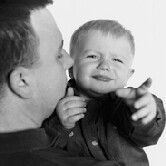
THURSDAY, April 28 (HealthDay News) — A brief checklist that parents can fill out while waiting to see their child’s pediatrician may aid in diagnosing autism earlier, new research suggests.
Researchers recruited 137 pediatricians in the San Diego area to give parents of 1-year-olds a 24-question screening test to fill out before seeing the doctor. The test was designed to detect general communication delays, not specifically autism, a neurodevelopmental disorder characterized by language and social deficits and repetitive behaviors.
“I wanted to change clinical practice in San Diego, to give pediatricians a simple tool to catch cases of autism and other disorders and get these kids into treatment earlier,” said Karen Pierce, an assistant professor in the department of neurosciences at University of California San Diego and assistant director of the UCSD Autism Center of Excellence. Early treatment is known to improve outcomes, she said.
The questionnaire asks about the child’s use of eye contact, sounds, words, gestures and other forms of communication. Questions include: Does your child smile or laugh while looking at you? Does your child pretend to play with toys? Do you know when your child is happy? Upset?
Babies who failed the screening were referred for more thorough assessments, including MRIs and a blood test, and were tracked until age 3.
Of nearly 10,500 babies screened, 184 underwent further evaluation. About 75 percent of those children were found to have autism or another language or development delay.
Currently, pediatricians have no way to screen for autism or other development delays until the child is older, Pierce said.
The study, funded in part by the U.S. National Institute of Mental Health, was published online April 28 in the Journal of Pediatrics.
Not only is the test fast and inexpensive, but the children it identified were referred for behavioral therapy at an average age of 17 months, much earlier than kids would be otherwise, Pierce said. A 2009 study from the Centers for Disease Control and Prevention found that, on average, children receive an autism spectrum disorder diagnosis at around 5.7 years old.
Dr. Andrew Adesman, chief of developmental and behavioral pediatrics at Schneider Children’s Hospital in New Hyde Park, N.Y., called the screening test promising.
However, Adesman noted that 972 kids, about three-quarters of those who failed the waiting room screening, were either not referred for further evaluation or never followed up with additional testing.
Possible reasons could be that the test wasn’t scored by staff, or that pediatricians determined there was no reason for worry and didn’t make the referral, Adesman said.
Of the 346 kids referred for further evaluation, 184 were tested by the UCSD researchers and tracked over time.
Thirty-two of those were eventually diagnosed with an autism spectrum disorder, 56 with language delay, 9 with developmental delay, 36 with “other” delay and 45 were considered a “false positive.” Five kids originally considered to have an autism spectrum disorder no longer met the criteria at follow-up.
“The very positive things about the study is it demonstrates earlier systematic screening for development delays for children at 1 year, is practical and relatively effective,” Adesman said. “The only concern I have is that a significant number of families never followed through with testing.”
The dearth of people who followed through with testing could make the test seem more accurate than it really is, Adesman said.
About 65 of every 10,000 children have autism, according to background information in the article. Statistically, that means the screening test caught about half of those who will eventually be diagnosed, Pierce said.
Even with fine-tuning, the test will never catch all cases of autism in 1-year-olds because some cases develop later in childhood or are marked by regression, in which the child develops mostly normally until age 18 months or so and then begins to lose developmental skills.
The screening test also would not pick up Asperger’s syndrome, which affects about 10 percent of kids with an autism spectrum disorder and does not involve language delays.
After the study, 96 percent of the pediatricians rated the program positively, and all of the practices have continued using the screening tool.
More information
The U.S. National Institute of Mental Health has more on autism.

